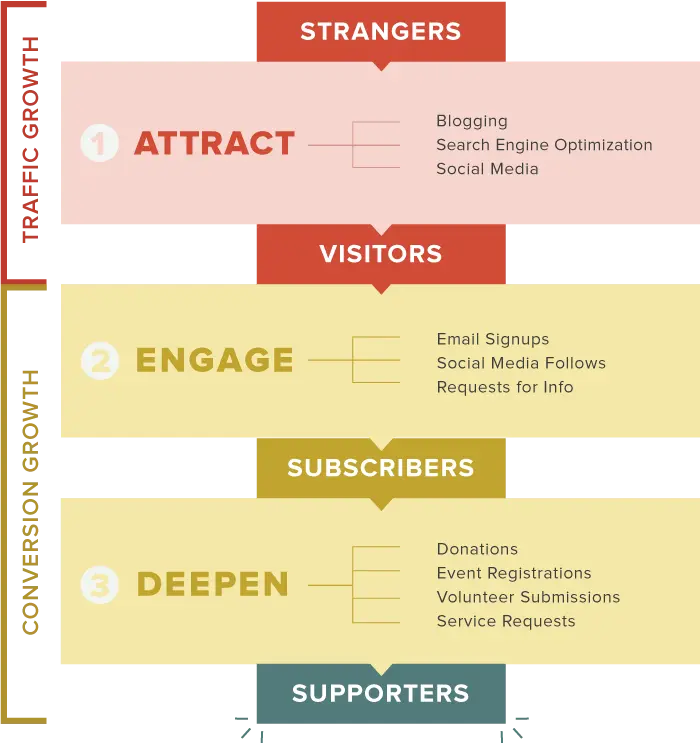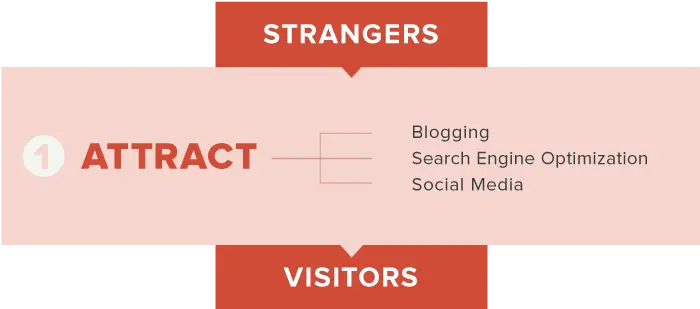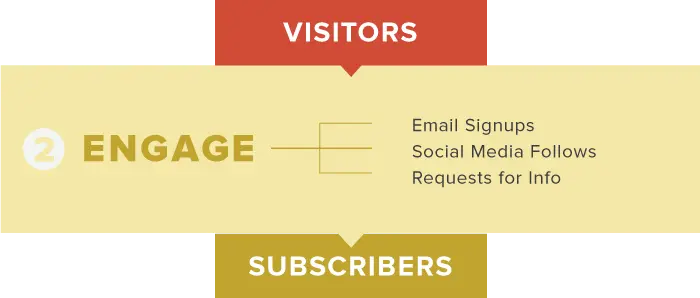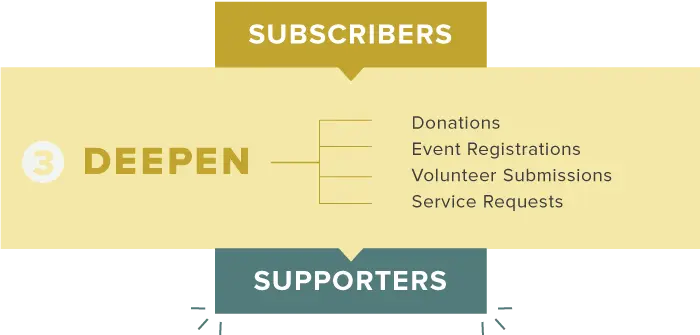Inbound marketing is a hot topic in the marketing world these days. And if you ask us, it’s for good reason.
Let’s take a quick stroll down the memory lane of marketing. It used to be that if you wanted to grow your base of supporters you had to first track them down. Once you found them, you had to somehow grab their attention. This often involved buying radio ads, running TV commercials and sending a whole lot of direct mail.
That’s not to say these channels are no longer useful. But for many nonprofits, there’s a better way than these traditional approaches to marketing aimed at grabbing attention. And it’s called “inbound marketing.”
What is Inbound Marketing?
Simply put, inbound marketing is an approach to marketing that brings supporters to you.
Traditional approaches to marketing are often “disruptive.” Things like TV commercials try to grab attention while viewers are interested in something else entirely. People aren’t actively looking for what’s in the commercial. They’re trying to watch their favorite sitcom.
By contrast, inbound marketing brings supporters to you (typically through your website) when they’re in the process of actively looking for an organization like you. Or at least the information you have to share. Instead of disrupting them from doing something else, you connect with people interested in your cause when they’re actively looking for the type of information you can provide. From there, you can start developing a relationship, turning them from a stranger into an active supporter.
The Stages of Nonprofit Inbound Marketing
Inbound marketing sounds pretty great, right? But perhaps you’re wondering what nonprofit inbound marketing actually looks like in practice? Here’s how we think of it.

Stage 1: Attract
The first step of nonprofit inbound marketing is all about attracting the “right people” to your website. People are a lot less likely to support your organization if they don’t know you exist.

So how do you drive visitors to your website? In our experience, the key is creating a ton of stellar blog posts and website content aimed at helping your potential supporters in some way. This could mean answering their questions. Or providing a solution to a common problem they may face. Think of what you can offer to your community to make their lives easier. And deliver it.
One of the best ways to drive more of the “right people” to your website is writing blog posts and website content optimized for search. This means determining what phrases people are typing into search engines like Google, and creating content that’s likely to show up in search results.
While the details of creating content optimized for search is beyond the scope of this post, the benefits of doing so can be huge.
A Nonprofit Example
Let’s say a local animal shelter wants to find loving homes for their cats and dogs. They start by thinking about who the “right people” are in their context. For them, this means animal lovers, those with pets and those looking to find a new cat or dog. The shelter realizes that if they provide helpful information related to pet ownership and caring for animals, they can draw in people who own pets already and are likely to provide a loving home to another lovable ball of fur.
They conduct keyword research and determine that a lot of people search for phrases like “best food for puppies” and “tips on kitten care.” They write a dynamite blog post about each that gradually start driving a healthy stream of traffic and get shared a bit on social media.
They’ve effectively turned these pet-loving strangers into visitors to their site. But that’s just the beginning. Now it’s time to take things a step further.
Stage 2: Engage
Attracting visitors is just the first step of nonprofit inbound marketing. Once a visitor lands on your site, you need to start the process of turning them from a passive visitor into an active subscriber.

The goal in this stage is to get a visitor to take some sort of action that starts the process of building a relationship. This can include actions like signing up for an email newsletter, following you on social media or requesting more information on your services.
While these actions aren’t necessarily beneficial to your organization in their own right, they’re a crucial step when it comes to cultivating a relationship with your visitors and guiding them towards supporting your cause.
A Nonprofit Example
Let’s stick with our animal shelter example. They realize their content is doing a great job of driving traffic from pet lovers, but this alone won’t lead to an uptick in adoptions. They decide to send a weekly email newsletter with profiles of their cutest and cuddliest critters. They put a simple signup form in the sidebar of their blog posts to drive up subscribers to this email list.
They also decide to create a downloadable PDF guide called “25 Tips for Training Your Pet.” They include their best tips based on questions they get asked all the time. They require visitors to input their email address in exchange for the guide, and include a checkbox on the form for visitors to easily subscribe to their weekly pet emails.
Stage 3: Deepen
At this point you’ve attracted strangers to your site and converted them from visitors into subscribers. Now it’s time to deepen that budding relationship and turn these folks into full-fledged supporters.

It’s important to remember these folks aren’t ATMs or a mindless stream of volunteer hours. They’re loving, caring, compassionate people looking to make a difference in the world. And you need to present your nonprofit as a way for them to make that difference.
Once you’ve built up trust, don’t be shy about presenting opportunities for these folks to deepen their involvement with your cause. Craft thoughtful calls to action. Make the process of donating or signing up to volunteer simple and intuitive. Showcase the difference your supporters make in the community and invite these subscribers to get involved.
Whatever “supporting your cause” looks like, make it easy for subscribers to do it.
A Nonprofit Example
Our animal shelter has done an awesome job growing their email list and already have a few thousand subscribers getting their weekly emails. They realize the final step in driving visitors to adopt a furry friend is to make the adoption process as easy as possible. They decide to put profiles of each pet on their site and link from the email to these profiles. They build an adoption inquiry form directly into their site and put prominent buttons on each profile pushing visitors to adopt.
They also routinely share stories from their pet parents on their blog. These supporters talk about their experiences as a pet parent, both the good and the bad, and give tips for those interested in adopting. They include links to these stories below the pet profiles in their emails and share them on social media. They have plans to create new guides and routinely publish helpful blog content to drive further traffic and engagement from visitors in the future.
Building Long Term Relationships
As a final note, it’s important to remember that getting a donation, volunteer application or service request isn’t the end of the road. Ensure you’re providing ongoing value to your supporters as well. Thank them regularly. Show them the difference they’re making in the world. And continue to create and share awesome content aimed at answering their questions and providing them with solutions.
Doing so will help ensure these supporters stay involved long into the future.
Have you tried inbound marketing? Or do you have questions about inbound marketing in the nonprofit space? We’d love to hear from you in the comments.

It is interesting. I have tried mostnofbthe things you mentioned and indeed itnworls out
Thanks a lot Nambowa!
This is very important information for me, I want to try this inbound marketing strategy and see how it goes.
Thanks for sharing the details
Glad to hear it Francis! Hope inbound marketing is a major help for your organization.